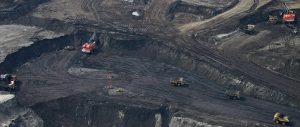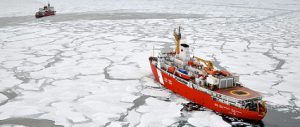Many of the risks [in the high Arctic] have always been there. The Arctic oil rush has been a long time coming. Since 1945, more than 10,500 wells, onshore and offshore, have been drilled within the Arctic Circle, with Russia responsible for most of the exploratory wells.
Greenland granted its first offshore licences as far back as the 1970s. Five wells were drilled, as well as one more in 2000, but none was successful. Interest dried up and the remaining licences were surrendered in 2001. The government came up with a new plan, and the result — a map showing the 20 licences the country has since awarded — is displayed at its Bureau of Minerals and Petroleum in Nuuk.
Jørn Skov Nielsen, the Danish deputy minister at the bureau, explains what changed. In 2001, the government decided to woo the oil and gas industry by holding more regular licensing rounds and using public money to buy seismic data and to commission environmental impact studies.
Licence rounds followed in 2002 and 2004. But the real breakthrough came in 2006-2007, when the government offered licences in Greenland’s northern Disko-Nuussuaq region, attracting the likes of ExxonMobil, Chevron and Canada’s Husky Energy. The lure is now such that in May 2010 — as anxiety over the dangers of offshore drilling reached its height during BP’s Gulf of Mexico oil spill — Greenland received 17 applications for its Baffin Bay area. The companies included ConocoPhillips, Shell and Cairn.
And what is happening in Greenland is only part of the story. The Arctic is hot. BP’s proposed alliance with Rosneft, the Russian state oil company, which collapsed in May, was about getting the group into the Russian Arctic. Shell is hoping to drill exploration wells next year in Alaska’s Beaufort Sea. Statoil, the Norwegian state-controlled group, already has a project in the Barents Sea. Twelve offshore wells have been drilled in the Arctic since 2010.
The physical challenges are immense. Drilling can only take place in the summer months when the ice has melted. There is little infrastructure and wells are expensive. But today’s rush is supported by oil prices of more than US$100 a barrel.
It is no surprise to find Cairn Energy in the race. The company has form: founded by Bill Gammell, a former Scotland rugby international and childhood friend of former US president George W Bush, Cairn struck oil in India at a field where Shell had previously failed to find anything. In 2002, Cairn bought Shell’s 50% share in the concession for a mere US$7.25 million before hitting the jackpot and becoming a FTSE100 company almost overnight.
The three wells Cairn drilled off Greenland last summer failed to find commercial quantities of oil and gas but showed signs of their presence. The programme this summer, which is supported by a fleet of four helicopters, six ice-management vessels to help tow icebergs out of the path of the drilling rigs and two emergency response ships, will cost US$600 million.
Earlier in August, Cairn announced its fourth well was also dry but said it remains undeterred. The company insists that despite the high costs, drilling off Greenland will be economical even at lower oil prices. A discovery that yields 500 million barrels would turn a profit from prices of US$40 a barrel, they say, while anything from 250 million barrels would make money at US$60 a barrel.
It is a huge exercise in logistics. Every 28 days, the company transports dozens of workers and contractors from its base in Edinburgh to Greenland and then on to its two drilling rigs, the Leiv Eiriksson and the Corcovado. As soon as the workers land in Nuuk, they are given a safety briefing in a hangar that belongs to the airport’s fire service. A well-thumbed copy of a thriller, Blowout, about a drilling ship that is sabotaged and then spills millions of gallons of crude oil into the Pacific Ocean, lies on one of the tables.
Experienced oil workers are in demand in Greenland, and their time is precious. After a cup of tea or coffee, they are searched to make sure they are taking nothing illicit offshore — workers must be teetotal during their stay — and then it is into a survival suit before taking a helicopter to the rig.
Out in the vastness of the Arctic, the only activity is the never-ending rhythm of the rig’s operations. The Greenpeace protest in June was an extremely rare interruption. Simon Thomson, Cairn’s CEO, says that he respects the right of the campaigners to express their opinion, but the company objects when “the way that voicing is expressed potentially compromises safety”.
As a result, Cairn now has an injunction in a Dutch court against Greenpeace, which forbids activists from disrupting its operations and breaking through the exclusion zone surrounding its ships. More broadly, Thomson insists that Cairn is doing nothing wrong. The company works in strict accordance with Greenland’s safety standards, which are modelled on Norway’s. It is employing two rigs. In the event of an accident on the seabed, the second rig is on hand to drill a relief well, which would intersect with the damaged well and pump cement down it. The company also has insurance and sufficient funding to deal with any potential incidents, he says.
In his Nuuk office, Nielsen, the deputy minister, is equally adamant that Greenland’s safety rules are among the toughest in the world and insists much of Cairn’s oil-spill response plan is public. But Greenpeace can claim to be making an impression. In August, Cairn’s plan — the absence of which from public view was the official pretext for the protest in June — was published in full by the government. The government said it was able to publish full details after tighter legal restrictions were imposed on how close campaigners can go to the drilling rigs.
The role of Greenpeace in Greenland remains complicated. Mikkel Myrup, the chairman of Avataq, a local environment group, says that his 50 members have a more nuanced attitude towards the oil industry than do international pressure groups. Myrup, who works as a curator at Greenland’s National Museum and Archives, says his group is not absolutely opposed to Cairn’s drilling, rather that it has sparked “a different kind of awareness about what this exploration could mean for the environment and marine life”.
Greenpeace, in particular, makes for an unlikely ally. Myrup credits the group with making “some good points” in its campaign against Cairn, but the group is generally disliked in Greenland. Its opposition to the seal trade in the 1980s had a big impact on people’s livelihoods. More important, says Myrup, is “for this young democracy to have a qualified discussion about the issues”.
The sun has finally broken through the clouds and Nuuk shows its brighter side. The centre is bustling with shoppers. Groups of middle-aged tourists just off a cruise ship and dressed in the latest outdoor gear, wander through the streets taking pictures.
But the debate about Greenland’s oil-based future goes on. In his office overlooking the harbour, Alfred Jakobsen, managing director of the country’s Organisation of Fishermen and Hunters, is poring over statistics. The organisation has recently commissioned research to compare its fish prices with those of competitors in Canada. Jakobsen says he is against offshore oil development, because “you cannot control the environmental conditions” and he worries about what a spill would do to his members’ livelihoods.
“We don’t know anything,” he says. “They send us lots of documents in English. We have to be given a chance to really listen to what this is all about and then consider.”
Carl Christian Olsen, president of Greenland’s Inuit Circumpolar Council (ICC), the international non-government organisation that represents around 150,000 Inuits of Alaska, Canada, Chukotka (Russia) and Greenland, is more optimistic. He says the government is recognising that it needs to take into account “the view of the public society”. The ICC, he says, has been focused on emphasising “a human dimension” to the debate about drilling in the Arctic, not just the environmental one.
These are the various conflicting demands that Greenland’s new administration must find a way to accommodate. The premier, Kuupik Kleist, remains pragmatic and he is one of the few who cautions that Greenland’s oil dream remains just that. Executives at the major oil companies, meanwhile, are looking forward to the next licensing round, planned for early 2012, for sites off the island’s north-east coast, now considered the most promising area.
Whatever happens, says Kleist, Greenland will play a very significant role in shaping the politics of the Arctic, which, if nothing else, must put the people of the high north at the centre of their changing world. “Now we are focusing on human beings more strongly,” he says. “We always had to yell, ‘We are people living the Arctic’. Today, I think, the message has been received and understood.”
Sylvia Pfeifer is the Financial Times’ energy editor. Christopher Thompson is a UK companies reporter for the FT.
For a video about Greenland’s oil rush go to www.ft.com/greenlandoil.
© Copyright The Financial Times Limited 2011
Homepage image of Greenland’s capital, Nuuk © Will Rose/Greenpeace




